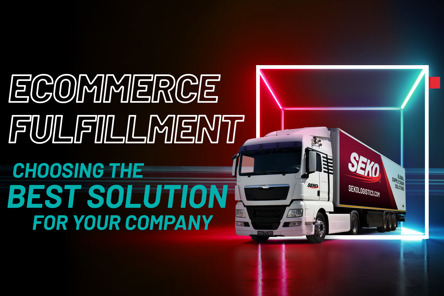For both a B2B or a D2Cecommerce company, a sale is not complete until the purchased items are received by the customer, making the order fulfillment process the heart of your business and key to building trust and affinity with your customer. Whether you manage order fulfillment in-house, with a third-party logistics provider (3PL) or by means of drop shipping, all solutions have one thing in common –they need to be predictable, accurate and efficient.
WHAT IS ECOMMERCE FULFILLMENT?
In the simplest terms, ecommerce fulfillment is the process of completing online orders.
For a web-based business, fulfillment encompasses everything from processing inventory, warehousing, packaging, shipping and delivery to managing returns and exchanges to completing value-add services such as gift-wrapping and engraving.
A seamless ecommerce fulfillment function is more critical than ever as consumers have become more and more accustomed to two-day, and even same-day, delivery options. Delayed or lost orders, poor tracking capabilities or a negative customer service experience can be detrimental to customer loyalty and overall brand reputation.
METHODS OF ECOMMERCE FULFILLMENT
The most popular methods of order fulfillment include in-house fulfillment, third-party fulfillment and drop shipping. The following section outlines the high-level characteristics of each solution:
In-house fulfillment involves a business fulfilling orders within their own facilities. This includes using its own labor, technology, warehousing and more without the help of an outside partner. In-house fulfillment is best suited for smaller businesses with lower inventory volumes, or those who seek complete control over the entire operation. It’s a great starting point for home-based businesses as it’s a relatively low-cost option. However, in-house fulfillment can become challenging for businesses needing to scale due to limitations on available warehousing space, labor and competitive shipping rates.
| Advantages of In-house Fulfillment | Challenges of In-house Fulfillment |
|
|
Third-party logistics (3PL) is a fulfillment method in which an outside 3PL, such as SEKO Logistics, is hired by a company to manage its entire supply chain from end-to-end. The transition to this model often occurs when companies outgrow their in-house fulfillment operation. 3PLs are also extremely beneficial for companies looking to scale their ecommerce businesses, both nationally and globally, while simultaneously improving service levels and the overall customer experience. While 3PLs are an outside provider, they act as an extension of a business, taking on the entire fulfillment process enabling the internal team to focus time and resources on other critical business functions.
| Advantages of Third-party Fulfillment | Challenges of Third-party Fulfillment |
|
|
Drop Shipping is a fulfillment method that involves forwarding online orders directly to the manufacturers or product suppliers to fulfill. The retailer doesn’t come into contact with inventory and instead, the supplier manages the entire process from point-of-sale to delivery. Drop shipping can be an attractive option due to its low start-up cost. Conversely, this fulfillment option gives complete control over the shipping and handling process to the supplier which can be detrimental to a company’s reputation if there are excessive delays, lost or broken items, or negative customer service experiences.
| Advantages of Drop Shipping | Challenges of Drop Shipping |
|
|
FINDING THE RIGHT SOLUTION
Transitioning fulfillment models to match a company’s growth trajectory is not uncommon, it’s expected. Whether just starting out or looking to chase after aggressive growth goals, it’s important for businesses to evaluate a variety of factors when determining the best ecommerce fulfillment solution. Some of the most notable considerations include:
- Capacity to manage part or all of the fulfillment process in-house (and scale efficiently)
- Availability of warehousing space–whether locally or globally
- Access to internal and customer-facing tracking technology
HOW SEKO CAN HELP
- Access distribution centers in every core market, including 5M square feet of logistics centers across Europe, North America and Asia. Couple that with global carrier, technology, airline and clearance partners and we’ve formed a living ecosystem all powered by teams of expert specialists located across the globe.
- Get closer to your customers - SEKO Ecommerce has more global coverage than any other logistics provider. In the U.S. alone, 75% of the entire population is within a 100-mile radius of a SEKO facility
- Improve speed of delivery - Buyer habits continue to evolve dramatically, and more consumers than ever expect next day delivery. SEKO Next Day Delivery is empowering companies worldwide to meet this demand and move at the speed of ecommerce.
- Scale your business with a single integration - We provide integrated global logistics for the entire ecommerce lifecycle –helping you to scale your business efficiently by growing order volumes into new markets, while enhancing customer satisfaction through simplified and sustainable delivery management.
- Improving utilization of supply chain capacity Working with ‘greener’ vendors
- Utilizing home compostable packaging
- Implementing energy saving solutions within facilities
- Driving growth in recommerce
With over 14 million parcels moved monthly, SEKO delivers a truly consistent global ecommerce shipping solution, while providing access to the resources and expertise of a single, seamless worldwide logistics company. Interested in learning more about how SEKO can help turn your business’ supply chain into a competitive advantage? Get in touch with a member of our team today: https://www.sekologistics.com/us/contact/
About SEKO
Built on nearly 50 years of logistics expertise, SEKO Logistics is the no-nonsense global end-to-end logistics partner –from factory to consumer. SEKO delivers sustainable client-first service, expert reliability and tech-driven shipping solutions that turn supply chains into a competitive differentiator. With over 150 offices in more than 40 countries, SEKO helps you move at the speed of commerce. Learn more at https://bit.ly/3C7ex4T



